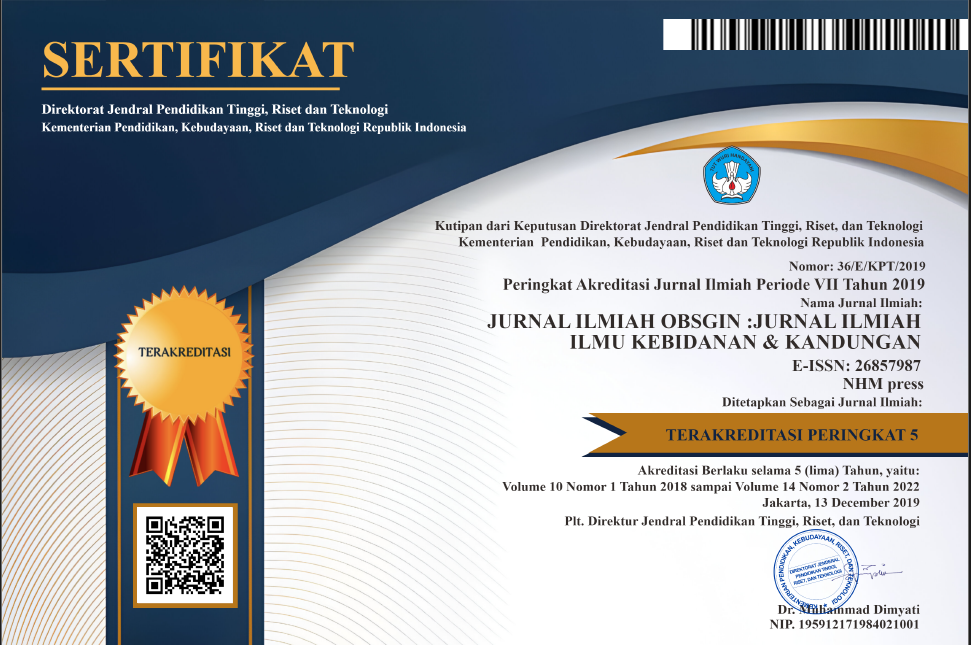Hubungan Penggunaan KB Suntik dengan Perubahan Berat Badan Akseptor KB di Desa Sumberwringin Kecamatan Klakah Tahun 2022
Abstract
Injection contraception is a method of contraception that is given by injection. The injection method has become part of the national family planning movement and its demand is growing. The high demand for injections is because
It is safe, simple, effective, does not cause interference and can be used after childbirth. The purpose of this study was to determine the relationship between the use of injectable contraceptives and changes in body weight of family planning acceptors. This observational study uses a descriptive analytical research design, namely research that explores how and why this health phenomenon occurs. Then analyze the dynamics of the correlation between phenomena or between risk factors and effect factors. Cross sectional methodology is employed. There were 32 participants in the study as a whole. Total sampling was used in this investigation, and a total of 32 participants were included in the sample. An observation sheet was employed as the method of data collecting (K4 card). Utilizing the SPSS application, statistical methodology. The findings revealed that out of 32 respondens, 21 had gained weight, 7 had a constant weight, and 4 had lost weight. The SPSS program’s statistical findings, which result in a P value <0.05 (H0 rejection), show a connection between injectable contraceptive use and changes in KB supporters’ body weight. To reduce the number of acceptors who experience weight gain by adjusting their diet and doing physical activity every day for at least 30 minutes.
References
BKKBN, 2015. Informasi Pelayanan Kontrasepsi. Jakarta : BKKBN.
Cahyono, T. 2015. Gambaran Berat Badan Akseptor KB Suntik di BPM Suyati
Desa Blambem Kecamatan Jambon Kab. Ponorogo. Universitas Muhammadiyah
Ponorogo.
Danny, Rizky. 2022. Pengertian Editing, Coding dan Tabulating.
https://SKRIPSI.202022/Pengertian.Editing,Coding,dantabulating_Brainly.co.id.
Dhita, Kris P. 2013. Perbedaan Perubahan Berat Badan Pada Akseptor KB Suntik
4 Minggu dan 12 Minggu di Puskesmas Teguhan Kecamatan Paron Tahun 2013.
Hartanto, 2013. Keluarga Berencana dan kontrasepsi. Jakarta: Pustaka Sinar Harapan.
Kemenkes. 2017. Profil Kesehatan Indonesia. Jakarta (online) https://pusdatin.kemnkes.go.id/resources/download/pusdatin/profil-kesehatan-indonesia/Data-dan-Informasi Profil-Kesehatan-Indonesia-2017.pdf
Melani, Farunti Iga. 2017. Gambaran Tingkat Pengetahuan Wanita Usia Subur Tentang Kontrasepsi. Yogyakarta. (online) https:repository.unjaya.ac.id/2443/FARUNTI%20MELANI%20%281114119%29nonfull%20%28NXPowerLite%20Copy%29-ilovepdf-compressed.pdf
Rahmawati, I., Norazizah, Y., Akademi, D., Islma, K., & Hikmah, A. 2014. Survey Penambahan Berat Badan Pada Akseptor KB Suntik 3 Bulan di Puskesmas Mayong. Jurnal Kesehatan dan Budaya, 7 (2), 3-7.
Robert, H Lusitng. 2021. Promoting Global Metabolic Health. San Francisco California (online) https://robertlusitng.com
Rosmalina, Ersa Dwi. 2016. Hubungan Penggunaan Kontrasepsi Suntik DMPA Dengan Perubahan Berat Badan Di Puskesmas Labibia Kota Kendari.Politeknik Kesehatan Kendari.
Sari, I. R. N., Kedokteran, F., & Lampung, U. 2015. Kontrasepsi Hormonal Suntik Depo Medroxyprogesterone Acetate (DMPA) sebagai salah satu Penyebab Kenaikan Berat Badan Injectable Hormonal Contraceptive Depo Medroxyprogesterone Acetate (DMPA) as One of the Causes Increase Weight. Universitas Lampung.
Siti, Nina., 2013. Keluarga Berencana dan Alat Kontrasepsi. Yogyakarta : Nuha Medika.
Susila, Ida ; Riski, T.O., 2015. Hubungan Kontrasepsi Suntik dengan Peningkatan Berat Badan Akseptor. Universitas Islam Lamongan.
Sugiyono. 2018. Metode Penelitian Pendidikan Pendekatan Kuantitatif,. Kualitatif, dan R&D. Bandung












